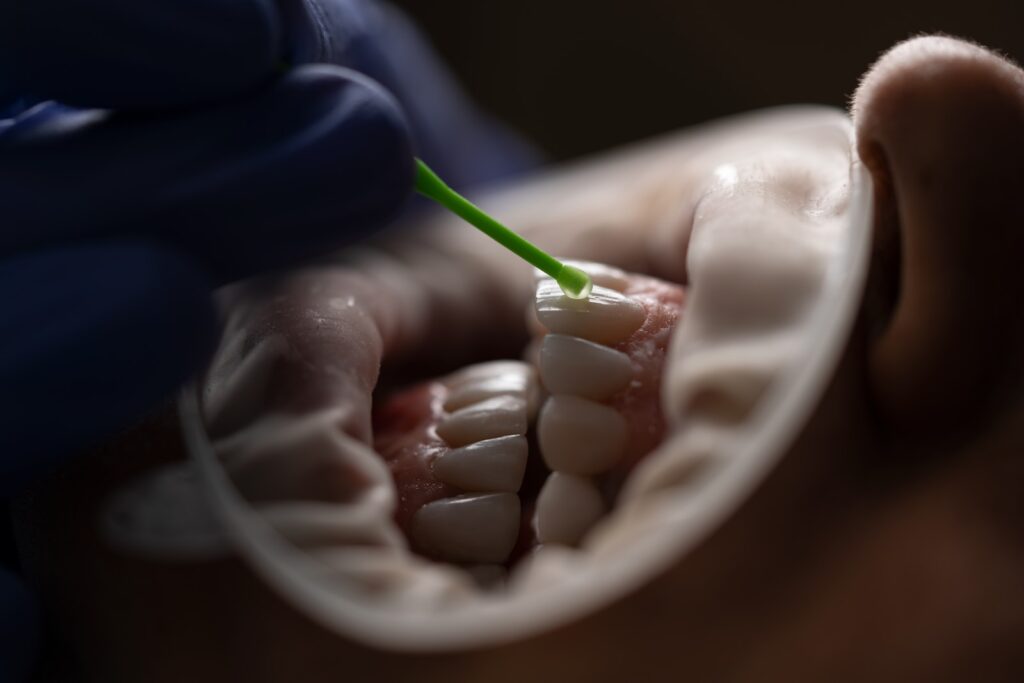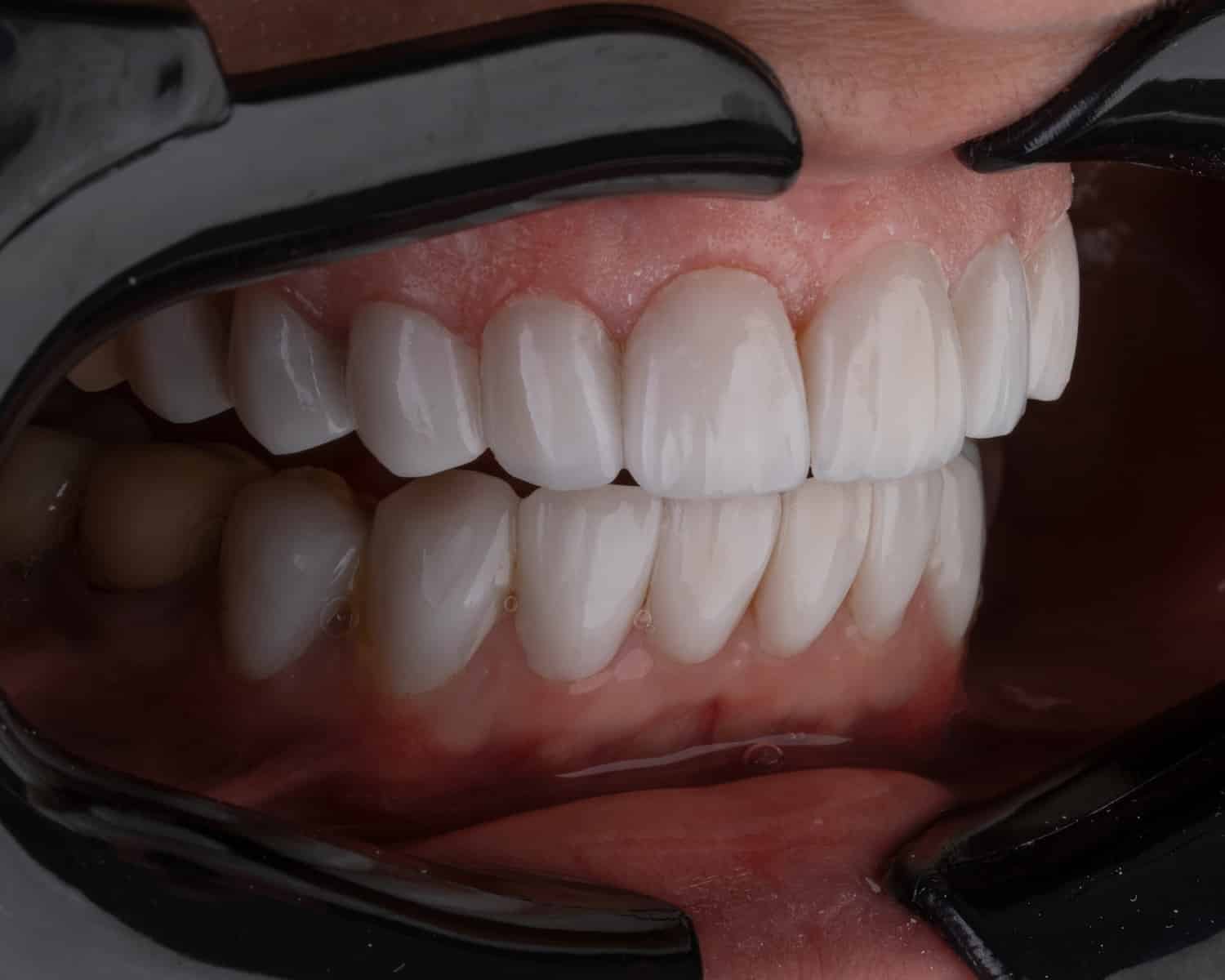Why crowns on front teeth are different
‘A smile is the best makeup a girl can wear’ said Marylin Monroe. Well, a good smile goes a long way for anyone. Teeth, especially front teeth, are central to that smile. You want them to look their best. Sometimes you need a little help from the dentist, for example with front teeth crowns. How does it work, and how are crowns on front teeth different from others?
In This Article:
- What is a dental crown?
- Crowns on front teeth: why they are different
- When are front teeth crowns necessary?
- Different types of crowns on front teeth
- Procedure for front teeth crowns
- Are crowns on front teeth visible?
What is a dental crown?
A dental crown, or simply a crown, is a tooth-shaped ‘cap’ that covers a damaged tooth or is positioned on top of a dental implant. This dental restoration is typically used for three reasons:
- To enhance the tooth’s appearance.
- Provide structural support.
- Restore a tooth to its normal function.
The crown is cemented onto the tooth and stays there permanently. The process often involves removing any decayed or damaged portions of the tooth, which sometimes requires tooth reshaping. If the tooth is weakened or has structural damage, we may recommend this procedure to enhance both the tooth’s aesthetics and its overall function.

Crowns on front teeth: why they are different
Dental crowns are like protective shields for damaged or weakened teeth. They’re usually associated with molars, but they can also work great on front teeth that have faced decay or trauma. These crowns function similarly to their molar counterparts, with some small distinctions.
Front teeth crowns play a big role in restoring the appearance of your smile. They are the center of it. They also play a vital role in the function of the teeth at the front of your mouth. They’re typically about two millimeters thick and are crafted from porcelain to blend seamlessly with your natural teeth.
Materials like gold or porcelain-fused-to-metal may not be the best choices because they don’t closely match your natural teeth. Over time, a metallic line can be visible. Therefore, patients often choose porcelain or zirconia crowns (or a mix of these materials) due to their durability and aesthetic appeal.
Typically, there are two main types available: full crowns and ¾ crowns, known as onlays. Full crowns cover the entire tooth but require more aggressive reshaping of the natural tooth. Onlays cover only a portion of the tooth, making them a good choice when the damage is less extensive.
Front teeth crowns serve a purpose beyond cosmetic enhancement. They’re essential for functions like cutting and tearing food. They’re also important for clear speech. These crowns are especially significant when front teeth exhibit major issues, like large cracks, extensive decay, breakage, deformities, or previous root canal treatments.
However, front teeth aren’t subjected to the same level of pressure as the molars. The strength and durability of non-metallic crowns like porcelain and zirconia are more than sufficient. A zirconia crown on a front tooth can last up to two decades, ensuring both functionality and a great smile.
Typically, any crown will last long and doesn’t need replacement quickly. Generally, 95% of crowns will remain in the mouth for at least five years. Research shows that 50-80% makes it longer than 15 years.
Front teeth crowns vary from other crowns for several reasons
- Shape and size. Front teeth have unique shapes and sizes, so their crowns are tailored to match these natural contours and blend seamlessly with neighboring teeth.
- Color. Since front teeth are highly visible, crowns for them must match the color and translucency of the surrounding teeth, often using materials like porcelain or ceramic. Sometimes a combination of materials is used.
- Bite. Front teeth have a different biting function, so their crowns are made to fit correctly and function properly.
- Material. Front teeth crowns use materials like porcelain or ceramic to closely resemble the natural appearance.
- Light Transmission. Front teeth are exposed to more light, so their crowns are designed to allow light to pass through. This helps to create a natural look.
When are front teeth crowns necessary?
As we’ve established, front teeth crowns serve various purposes. Most importantly, they help enhance the appearance, strength, and function of the front teeth.
Front tooth crowns are typically recommended in specific scenarios. These situations include addressing severe tooth decay, which can create cavities caused by bacterial and acid erosion. While smaller cavities may be resolved with fillings, larger or neglected cases may benefit from the added protection and restoration provided by a dental crown.
Additionally, substantial damage to a front tooth resulting from forceful trauma, such as a significant chip, may require a front tooth crown for effective restoration.
Another scenario is when front teeth undergo root canal procedures to address damage or infection within the tooth, a process typically simpler due to the reduced space between the tooth’s outer surface and the root. In such cases, a dental crown is often placed over the front tooth to safeguard the treated tooth and maintain its strength. This occurs less often.
Different types of crowns on front teeth
Dental crowns come in various types. That goes for all teeth, also front teeth crowns. Each has its unique characteristics.
Porcelain crowns
These crowns are popular for their natural appearance, closely resembling your real teeth. This material is most often used for crowns on front teeth. They are highly durable and can last for many years. The procedure typically involves reshaping the tooth and taking impressions for the crown. Porcelain crowns tend to be moderately priced.
Zirconia Crowns
Zirconia crowns are known for their strength. They are among the most durable options, capable of withstanding significant wear and tear. The procedure for zirconia crowns typically includes tooth preparation and impressions. They are in the mid to high price range.
In reality, zirconia crowns on front teeth are often layered with porcelain. Zirconia has one even color, which makes it look less natural. The porcelain layer can be made in color variations, mimicking your real teeth much better.
Resin Crowns
Resin crowns are an economical choice, but are less durable compared to other crown materials. They may need more frequent replacements. The procedure typically involves tooth shaping and the placement of the crown. They are usually on the lower end of the price spectrum.
Metal crowns
Less frequently used, but still a possibility, are metal crowns. These crowns are made from materials like gold or chromium. They’re exceptionally durable and resistant to damage. However, they have a metallic appearance that makes them more suitable for back teeth. The procedure typically involves tooth preparation and cementing the crown. Metal crowns are budget-friendly.

Procedure for front teeth crowns
Your journey to crowns on front teeth begins with an initial consultation. During this visit, we evaluate the condition of your tooth to determine if a crown is the most suitable solution for your specific dental issue. We will discuss your treatment options and address any concerns you may have.
Your dentist takes measures to ensure your comfort throughout the procedure with an anesthetic. At the same or a subsequent appointment, the dentist carefully shapes and trims the damaged tooth on all sides. This shaping process is essential for creating a tooth-shaped mold that will serve as the blueprint for your custom permanent crown. The mold is prepared and sent to a specialized dental laboratory, where technicians make your permanent crown. In the meantime, a temporary crown is placed over the prepared tooth to protect it and maintain functionality.
Once your permanent crown is ready, you’ll return to our dental clinic in Edina for the placement. We will administer an anesthetic as necessary. After the removal of the temporary crown, we replace it with a custom-crafted permanent crown. This placement may require several adjustments to achieve the perfect fit. Once the desired fit is achieved, the permanent crown is securely sealed into place using strong dental cement. Of course, any excess cement is carefully removed.
After the placement of the permanent crown, it is essential to schedule routine checkup appointments. These appointments serve to monitor the alignment, appearance, and functionality of the crown. Your dentist will ensure that the crown continues to meet your specific dental needs and that it remains a comfortable and natural addition to your smile.
Are crowns on front teeth visible?
At Mint Dental, we want to make sure you are happy with the crowns on your front teeth, which means they should look perfectly natural. Our front tooth crowns are designed to seamlessly blend with your natural teeth, ensuring they are not noticeably different.
Crowns on front teeth are exceptionally thin, typically measuring only about 2 mm in thickness. This slim profile contributes to their inconspicuousness, especially when compared to crowns on back teeth.
